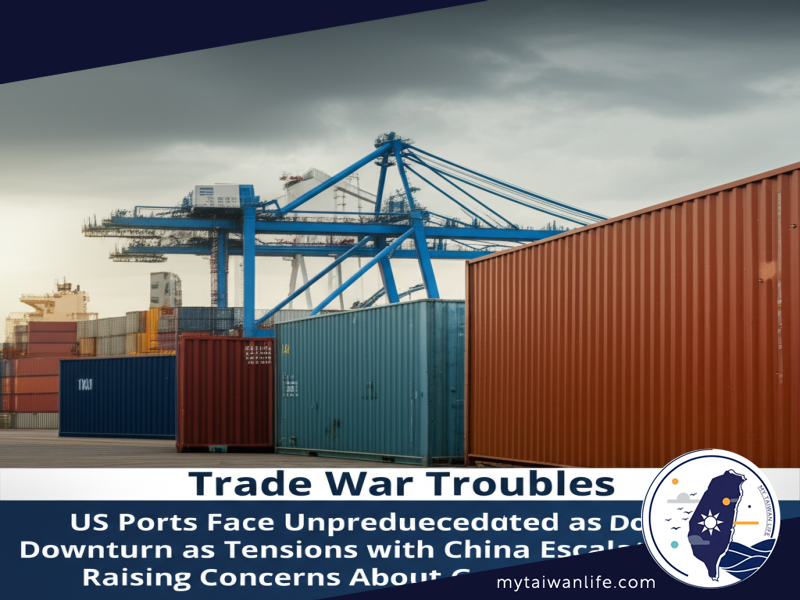Cargo Freeze: Zero Ships Sailing From China to Key US Ports, A Post-Pandemic First
Trade War Troubles: US Ports Face Unprecedented Downturn as Tensions with China Escalate, Raising Concerns About Goods and Prices.

A stark reality has emerged at major US ports: for the first time since the height of the pandemic, not a single cargo vessel has departed China bound for the West Coast's key gateways. Officials from the West Coast ports of Los Angeles and Long Beach, two of America's busiest, shared this alarming observation with CNN, painting a picture of significant disruption in the US-China trade relationship.
Just six days prior, 41 vessels were scheduled to leave China destined for the San Pedro Bay Complex, which includes both the Port of Los Angeles and the Port of Long Beach. By Friday, the number had plummeted to zero. This dramatic shift is largely attributed to the trade war initiated by President Donald Trump, which imposed substantial tariffs on Chinese imports. The result? Fewer ships carrying less cargo are now navigating to US ports.
This situation has prompted concern not only about the absence of vessels leaving China but also about the speed of this decline. "That’s cause for alarm," stated Mario Cordero, CEO of the Port of Long Beach. He further noted that they are "seeing numbers in excess of what we witnessed in the pandemic" in terms of canceled voyages and reduced vessel arrivals. The Port of Long Beach is grappling with a 35-40% drop in cargo volume compared to typical levels. The Port of Los Angeles is facing a 31% decrease this week, and the Port of New York and New Jersey is bracing for a potential slowdown.
Adding to the concern, the Port of Seattle reported zero container ships in port on Wednesday, an anomaly unseen since the pandemic. "That’s because just nothing is being shipped over," according to port commissioner Ryan Calkins. The US and Chinese trade representatives are scheduled to meet in Geneva over the weekend in an effort to de-escalate the trade war. Currently, most goods shipped from China to the United States face a 145% tariff, with US exports to China being hit with a 125% tariff. On Friday, President Donald Trump floated the possibility of reducing the tariff rate with China to 80%, although the final decisions would be left to Treasury Secretary Scott Bessent.
For consumers already confronting higher prices or shortages, Cordero underscored the urgency for a resolution. “If things don’t change quickly, I’m talking about the uncertainty that we’re seeing, then we may be seeing empty products on the shelves. This is now going to be felt by the consumer in the coming 30 days,” Cordero warned.
China accounts for a substantial portion of imports through the Port of Long Beach, representing upwards of 63% of the incoming cargo. However, this figure has declined from 72% in 2016, as retailers diversify their sourcing due to the ongoing trade tensions. Nevertheless, China remains a vital source of imports for the United States. Maersk, the second-largest shipping line globally, revealed to CNN that the cargo volume between the US and China has plummeted by 30-40% compared to the norm. "If we don’t start to see a de-escalation of the situation with China, if we don’t start to see more of those trade deals, then we could be in a situation where some of these effects get more entrenched and are more adverse," said Maersk CEO Vincent Clerc.
Other Versions
Congelación de la carga: Cero buques desde China a puertos clave de EE.UU., una primicia tras la pandemia
Gel des cargaisons : Aucun navire ne quitte la Chine à destination des principaux ports américains, une première après la pandémie
Pembekuan Kargo: Tidak Ada Kapal yang Berlayar dari Tiongkok ke Pelabuhan Utama AS, Hal Pertama Pasca-Pandemi
Blocco dei carichi: Zero navi in navigazione dalla Cina verso i porti chiave degli Stati Uniti, una novità post-pandemia
貨物凍結:パンデミック後初、中国から米国の主要港への船舶出航ゼロ
화물 동결: 팬데믹 이후 처음으로 중국에서 미국 주요 항구로 항해하는 선박 제로
Pag-freeze ng Cargo: Walang Barko na Naglalayag Mula sa Tsina Patungo sa Mahahalagang Pantalan ng US, Isang Unang Pagkatapos ng Pandemya
Заморозка грузоперевозок: Ноль судов, идущих из Китая в ключевые порты США, - первый случай после пандемии
สินค้าแช่แข็ง: ไม่มีเรือขนส่งสินค้าจากจีนไปยังท่าเรือสำคัญของสหรัฐฯ เป็นครั้งแรกหลังยุค
Đóng băng hàng hóa: Không có tàu nào khởi hành từ Trung Quốc đến các cảng lớn của Mỹ, Lần đầu tiên sau đại dịch

